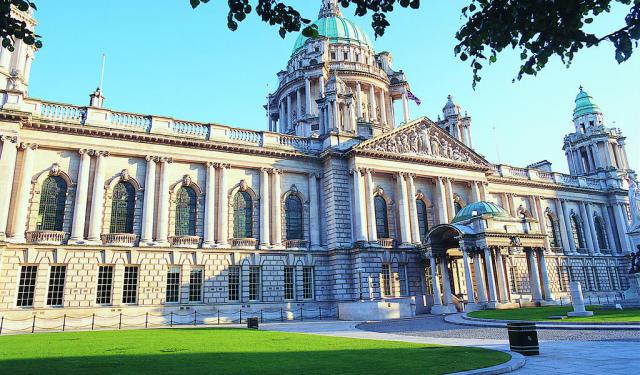St. George's Church, Belfast
Saint George’s Church is a serene oasis steeped in centuries of history. The current Georgian-style building was completed in 1816, designed by Dublin-born architect John Bowden, and is celebrated as the oldest Church of Ireland congregation in the city. Its location is particularly significant-it stands on a site used for worship since at least 1306, where the Rivers Lagan and Farset once met and a chapel served those crossing the mudflats that defined early Belfast. The dramatic Corinthian portico at the west entrance originally adorned Ballyscullion House and was relocated here in the early 19th century, lending the church an air of refined elegance.
Inside, visitors are greeted by a lofty nave framed by three-sided galleries and richly adorned with Victorian-era enhancements. In 1865, architect W. J. Barre exposed and ornamented the ceiling trusses and added a finely carved pulpit two years later. The chancel, added in 1882, showcases vivid paintings by Alexander Gibbs and a beautiful oak choir screen, creating a striking contrast with the sandstone simplicity of the nave.
Saint George’s is also renowned for its vibrant High Church traditions and flourishing musical heritage. Home to one of the few men-and-boys choirs in Ireland, it offers sung services including weekly Choral Eucharist and Evensong-a living tribute to its longstanding liturgical excellence. With its inclusive ethos, the church reaches out to diverse communities, from city professionals to those experiencing homelessness.
For tourists, Saint George’s offers more than a glimpse into ecclesiastical architecture-it’s a peaceful sanctuary where history and spirituality converge. Open most weekdays, the church welcomes all to reflect in its tranquil surroundings, admire its stained glass, and soak up the gentle beauty of one of Belfast’s most historically resonant landmarks.
Inside, visitors are greeted by a lofty nave framed by three-sided galleries and richly adorned with Victorian-era enhancements. In 1865, architect W. J. Barre exposed and ornamented the ceiling trusses and added a finely carved pulpit two years later. The chancel, added in 1882, showcases vivid paintings by Alexander Gibbs and a beautiful oak choir screen, creating a striking contrast with the sandstone simplicity of the nave.
Saint George’s is also renowned for its vibrant High Church traditions and flourishing musical heritage. Home to one of the few men-and-boys choirs in Ireland, it offers sung services including weekly Choral Eucharist and Evensong-a living tribute to its longstanding liturgical excellence. With its inclusive ethos, the church reaches out to diverse communities, from city professionals to those experiencing homelessness.
For tourists, Saint George’s offers more than a glimpse into ecclesiastical architecture-it’s a peaceful sanctuary where history and spirituality converge. Open most weekdays, the church welcomes all to reflect in its tranquil surroundings, admire its stained glass, and soak up the gentle beauty of one of Belfast’s most historically resonant landmarks.
Want to visit this sight? Check out these Self-Guided Walking Tours in Belfast. Alternatively, you can download the mobile app "GPSmyCity: Walks in 1K+ Cities" from Apple App Store or Google Play Store. The app turns your mobile device to a personal tour guide and it works offline, so no data plan is needed when traveling abroad.
St. George's Church on Map
Sight Name: St. George's Church
Sight Location: Belfast, Ireland (See walking tours in Belfast)
Sight Type: Religious
Sight Location: Belfast, Ireland (See walking tours in Belfast)
Sight Type: Religious
Walking Tours in Belfast, Ireland
Create Your Own Walk in Belfast
Creating your own self-guided walk in Belfast is easy and fun. Choose the city attractions that you want to see and a walk route map will be created just for you. You can even set your hotel as the start point of the walk.
Belfast Introduction Walking Tour
For over a century, the political situation of Belfast, the capital of Northern Ireland, has been the source of strife, first between the Crown-loyal Protestants and Irish Catholics, and more recently between the United Kingdom and the European Union.
Sitting on the banks of the River Lagan where it meets the Irish Sea, the city owes its name to this coastal condition, with "Belfast"... view more
Tour Duration: 2 Hour(s)
Travel Distance: 3.8 Km or 2.4 Miles
Sitting on the banks of the River Lagan where it meets the Irish Sea, the city owes its name to this coastal condition, with "Belfast"... view more
Tour Duration: 2 Hour(s)
Travel Distance: 3.8 Km or 2.4 Miles
The Troubles and Peace Process Landmarks
Decades past the official end of The Troubles in Belfast, the price of peace in Northern Ireland remains high. One of the means with which to secure it, back in 1969, was erecting a wall to physically separate the capital's warring Protestant and Catholic communities. Known since as the Peace Wall, the structure has become a popular tourist attraction for the multiple murals painted thereon... view more
Tour Duration: 1 Hour(s)
Travel Distance: 2.1 Km or 1.3 Miles
Tour Duration: 1 Hour(s)
Travel Distance: 2.1 Km or 1.3 Miles
Belfast Victorian Architecture Jewels
Described as “modestly scaled, undemonstrative, somewhat solid in aspect, and usually restrained (sometimes even austere) in its use of external decoration”, the urban landscape of Belfast has been influenced by the demands of shipbuilding and linen industry, much as transitioning between culture, arts, commerce, and education. Still, the architectural spectrum of the city is quite broad and... view more
Tour Duration: 2 Hour(s)
Travel Distance: 2.9 Km or 1.8 Miles
Tour Duration: 2 Hour(s)
Travel Distance: 2.9 Km or 1.8 Miles






